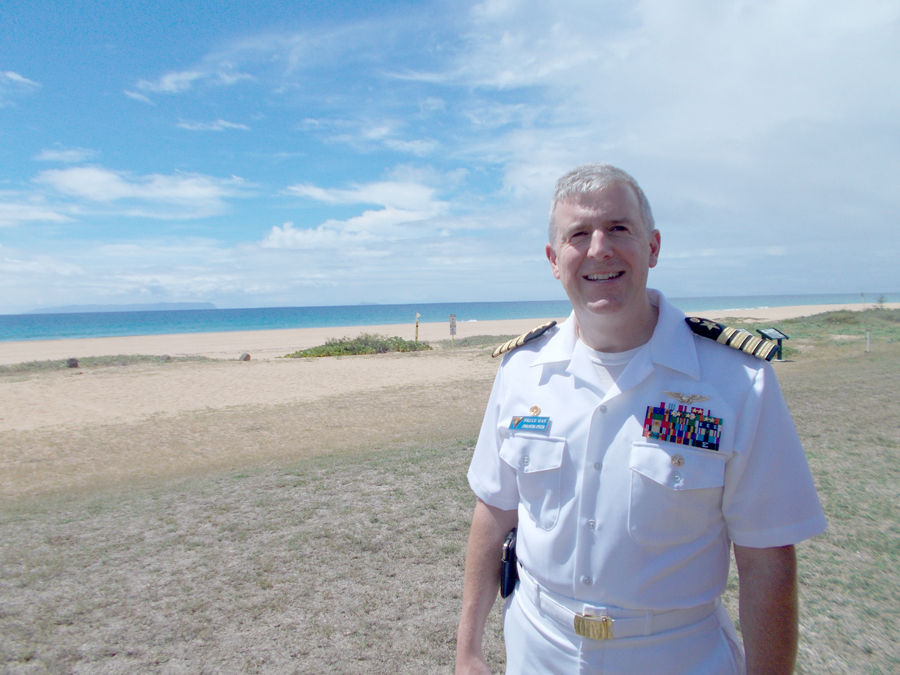LIHUE — Kauai residents had a chance to engage face-to-face Thursday night with Navy officials, including those who analyze the environmental impacts of military training activities in Pacific waters and want the public’s feedback. The Navy is preparing an evaluation
LIHUE — Kauai residents had a chance to engage face-to-face Thursday night with Navy officials, including those who analyze the environmental impacts of military training activities in Pacific waters and want the public’s feedback.
The Navy is preparing an evaluation of potential environmental effects associated with its planned military training, testing and research in Hawaii and Southern California waters after 2018. The intent of the meeting at Island School about the intersection between the environment and future Navy training in the two states was to identify community concerns and answer questions.
“The big thing right now is we’re really just looking for public input that can be included in our analysis,” said Lt. Cmdr. Matt Knight, a U.S. Pacific Fleet spokesman.
Kauai was chosen as one of three public meeting locations for Hawaii and California due to the important role played by the Pacific Missile Range Facility at Barking Sands, officials said.
“We want to be able to operate and train and co-exist with nature,” said Capt. Bruce Hay, commander of PMRF. “We want, and the public wants, to make sure that our training is responsible.”
Anne Wilson Schaef of Kilauea said she attended the open house-style meeting because she’s concerned about any negative consequences that Navy training activities might have on the environment.
“We’re concerned about our marine environment — the whales and the dolphins and the seals and the fish and corals,” she said. “It seems like they are trying to take those things into consideration, but the nature of the beast is there maybe isn’t a good convergence between warfare preparation activities and nature. Our hope is to find a good convergence.”
All in all, Schaef said she found the meeting to be worthwhile.
“To me, it seems more of a promotional thing, though we are getting better informed,” she said. “We’ve asked the question now three times, ‘Do you take into consideration the research of non-government agencies?’ and we’re getting squirrely answers on that.”
Earlier this year the Navy agreed to limit its use of sonar off Hawaii and Southern California through 2018. The deal bans sonar and explosives training on the eastern side of the Big Island and north of Molokai and Maui, as well as locations in California.
Until it expires, the agreement will help protect habitat for some of the most vulnerable marine mammal populations, such as endangered blue whales, for which waters off Southern California are a globally important feeding area; and numerous small, resident whale and dolphin populations off Hawaii.
The environmental impact study that was the topic of Thursday’s meeting, however, specifically addresses planned Naval activities after the deal’s expiration.
Alex Stone, a project manager for the Pacific Fleet in San Diego, said the new environmental study will take into consideration all that was agreed to in the settlement, but it won’t necessarily carry those changes over into the future.
“In the settlement, if we agreed to not do sonar in a certain area, the (environmental impact statement) will look at: Does it make sense to continue that? Is there a benefit to the environment? Is there an impact to training?” Stone explained. “We can do that better through this process than when we were in the heat of litigation.”
The Navy’s planned activities in Pacific waters include few fundamental changes for the period starting in 2018, Stone said. Mainly, the study will differ from previous ones in that it will take into consideration new scientific data, he said.
“We’re still operating in the PMRF range, we’re still operating around Pearl Harbor, we’re still running that huge exercise, RIMPAC, every other summer,” Stone said, referring to the Rim of the Pacific Exercise, which happens in Hawaiian waters and is the largest international maritime warfare training event in the world. “We’re really not changing the scope of what we do or how we do it. The reason for this is that our permit is set to expire in 2018.”


